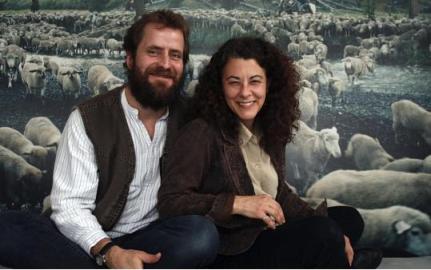
An unsentimental elegy to the American West, SWEETGRASS follows the last modern-day cowboys to lead their flocks of sheep up into Montana’s breathtaking and often dangerous Absaroka-Beartooth mountains for summer pasture. Ilisa Barbash and Lucien Castaing-Taylor completed SWEETGRASS in early 2010 and spent the past year screening the film in festivals and theaters.
Producer Ilisa Barbash answered some questions from LEF Program Assistant Nellie Kluz.
Nellie: What was the biggest surprise you had while recording SWEETGRASS?
Ilisa: It’s got to be how fascinated we became by the sheep. Seriously, they have played a significant role in human history, and religious iconography. Individually sheep are at once docile and stubborn, funny and bland. En masse they are a force to be reckoned with. Aesthetically they are remarkable from the texture of their wool, the deliberate strides of their hooves, to their almost fluid like formation when they swarm together through the ranch gates.
The themes of the film shifted surprisingly as we edited. We always imagined that the sheep drive into the mountains would be the central thread of the film. We also supposed we wouldn’t use any narration. I was not sure about interviews. As outsider, though, I thought that we needed to explore some kind of contentious issue in the film—a debate about land use. The ranchers had government permits to herd their sheep into public lands. There were environmentalist groups in the area, and East Coast hobby ranchers who objected to that use. Initially I imagined that some of these controversies might make an interesting film and so I filmed appropriate sequences in the flatlands. But as Lucien filmed separately in the mountains, and as we watched the footage he brought down, we realized to our surprise how interesting and almost viscerally satisfying the sheep drive was — the people, the sheep, the landscape. And so we went back to our simple thread, and made a film that is more experiential and nuanced than the issue film I’d first imagined.
Nellie: Can you talk a bit about the distribution strategy that’s been used for the film? As a team, you’ve made other films that were placed more within an ethnographic film context – what made you feel that something different was in order for SWEETGRASS?
Ilisa: Our earlier film, In and Out of Africa, has found its best reception with an academic audience. We have to admit that this time around with SWEETGRASSwe decided to just make a film we liked, rather than cater to any particular audience. As we edited we realized that sound and image were as or even more important to us than a story, so we raised money (most from the LEF Foundation) to blow the film up to 35mm from the video we had shot it on. And because of that it has had a much more successful festival and theatrical life than we could ever have imagined. It’s a world that appeals to Americans—a contemporary Western, or as one reviewer put it “a grand documentary Western.” Westerns belong in theaters on big screens, with popcorn.
Nellie: From a lot of reviews, it seems like SWEETGRASS has ended up bridging different worlds: the rural Western sheepherding lifestyle of your subjects and the audiences that see it in a context like New York or Boston, or internationally. How have the people in the film responded to the critical acclaim surrounding SWEETGRASS, since it’s so linked to the movie versions of themselves?
Ilisa: This is a tricky issue because of course, one cannot really do justice to anyone through a film portrait. So much gets left out and anything you do only touches superficially on any kind of reality. I think that question is best answered by the people themselves. When the film first came out it was reviewed in the New York Times, and people wrote in, commenting on the moment when Pat, one of the herders calls his mother in a moment of distress. Pat’s 16 year old daughter immediately penned a letter to the New York Times, saying:
Pat Connolly which is one of the sheepherders in SWEETGRASS is my dad. I encouraged everyone to watch SWEETGRASS i believe it will give people a sense of the reality of the “frontier”. I have in a Frontier Lit. class in highschool right now and our whole theme is “What is the frontier”? I do not think some people realize that this movie is not all about the landscape, but the hard work. In the trailer of the movie my dad breaks down on the phone with my grandma. This is the reality, he is not being a baby. At this time he was trying to raise me and it was hard for him cause he was not making a lot of money and it was hard work….
I look up to my dad for spending all summer in the beautiful, lonely, endless mountains with stubborn sheep. I am sure my dad cussed a lot knowing him but, i hope people do not think he is a bad guy. Its just the reality. Try to imagine how frustrated he was. Through all the hardships and good times that came a long with this trip i know its something my dad will never forget. I hope everyone enjoys this movie and learns a little bit from. I cannot wait till it comes to theatres here! My dad and i are sure tickled about this and wish Lucien the best luck and we hope to see you soon!”
Nellie: You’ve been working on this film since 2001 – what’s next for both of you?
Ilisa: It’s hard for us to talk about future projects before they’ve become something tangible. We’ve embarked on a new project on the East Coast that, to our surprise, raises many of the same issues as SWEETGRASS. The main subjects may even end up being Norwegians again! Lucien’s also been filming various pastoral pieces in the Alps and the Pyrenees and I am working on two books about still photography.
SWEETGRASS is now available on DVD:http://sweetgrassthemovie.com/

